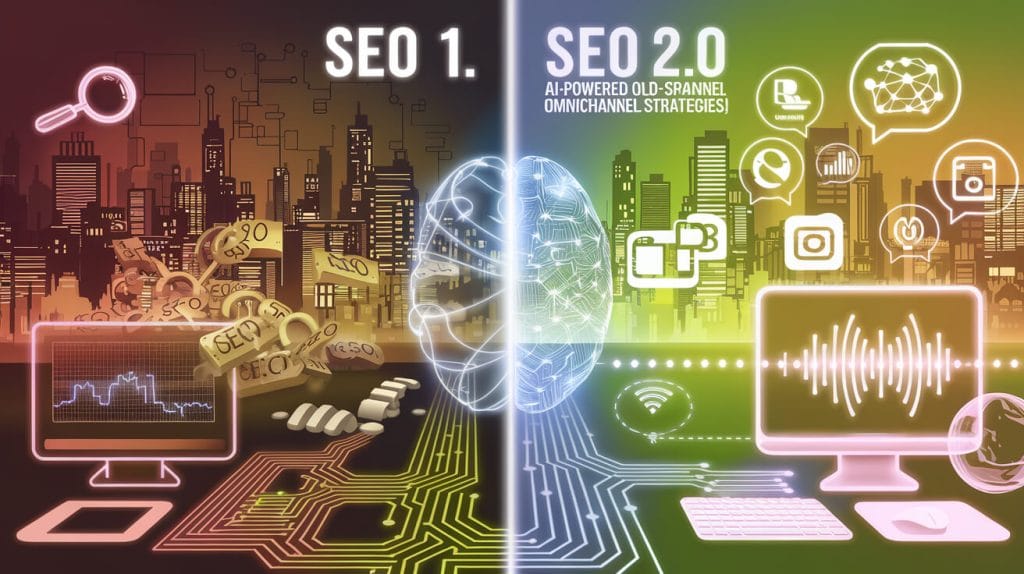You wake up, grab coffee, check your analytics… and your stomach drops. Organic traffic’s in freefall. Rankings vanished. Leads dried up. You scramble: “Did Google drop another update? Are my keywords dead? Is SEO even worth it anymore?”
Sound familiar? I’ve been there. Clients panic-called me last month when their “SEO 1.0” playbooks stopped working. Here’s the hard truth: Traditional SEO is gasping for air. But the game isn’t over—it’s evolved. Welcome to SEO 2.0.
The Ticking Clock Every Marketer Ignores
Remember when SEO meant stuffing keywords, chasing backlinks, and praying to Google’s algorithm gods?
That worked—until AI started answering queries directly. Until TikTok became Gen Z’s Google. Until voice search made “near me” the default for local businesses.
Here’s what changed:
- 63% of searches now happen outside Google
- AI tools like ChatGPT answer questions without sending a single click to your site
- Google’s “AI Overviews” scrape your hard-earned content to keep users on their page
SEO 2.0 isn’t optional. It’s survival.
The Death of Traditional SEO? Not Quite…
Let’s clear this up: SEO isn’t dead. But the “engine” in “search engine optimization”? That’s expanding. Think of SEO 1.0 as a dial-up modem. It got you online, but today’s broadband world demands more.
SEO 2.0 is omnipresent optimization. It’s about being wherever your audience searches—whether that’s Google, YouTube, Amazon, or an AI chatbot.
Last week, a bakery client asked me: “Why bother with SEO if nobody clicks through from AI answers?” My reply: “Because SEO 2.0 isn’t just about clicks. It’s about becoming the source AI quotes, the brand TikTok trusts, the answer Alexa reads aloud.”
How COVID Accelerated the SEO Apocalypse
Remember 2020? Businesses scrambled online, flooding Google with content. Algorithms got smarter. Users got impatient.
By 2024, something snapped. Google started prioritizing AI-generated answers. Social platforms became search engines. Voice assistants outnumbered humans in some households.
Suddenly, ranking #1 on Google meant nothing if your content didn’t:
- Feed AI overviews
- Dominate YouTube searches
- Pop up in smart speakers
That’s when the SEO 2.0 era officially began.
What Exactly Is SEO 2.0?
Let me break it down bluntly: SEO 2.0 is search optimization for a world where “search” happens everywhere except search engines. It’s not just about keywords and backlinks. It’s about:
- Being the source AI quotes (even if users never visit your site)
- Owning social media search results (TikTok’s Gen Z’s #1 product research tool)
- Optimizing for voice assistants (40% of U.S. homes have smart speakers)
- Appearing in ChatGPT-style answers (where “I’ll Google it” becomes “Ask the AI”)
Last month, I saw a LinkedIn post rank in Google’s AI Overview for “content marketing tips”—without the author ever optimizing for Google. That’s SEO 2.0 in action.
From Search Engines to “Search Everywhere”
Let’s get technical. SEO 2.0 has three pillars:
- Omnichannel Presence: Your content lives on YouTube, Reddit, Amazon—anywhere people seek answers.
- AI-First Optimization: Structuring content so AI tools can easily scrape and quote it.
- Experience over Keywords: Google now ranks based on user satisfaction signals, not just metadata.
Here’s a story: A fitness coach client doubled leads without improving Google rankings. How? By optimizing YouTube videos for “how to fix lower back pain” queries. His videos now dominate smart TV searches—where his audience actually watches.
The Three Pillars of SEO 2.0 (and Why You’re Probably Missing One)
Most businesses fail at SEO 2.0 because they hyperfocus on one channel. Let’s fix that.
Pillar 1: Own the AI Food Chain
Google’s AI Overviews work like this: They scrape content from high-authority sites, mash it into an answer, and leave your site unclicked.
Your play? Become the source they scrape. How:
- FAQ-style content with clear, concise answers
- Schema markup to help AI understand your content’s purpose
- Backlinks from .edu/government sites (AI trusts these most)
A vegan recipe site I worked with added 50 FAQs to their blog. Three months later, their content appeared in 12% of AI Overviews for recipe-related queries—without any ranking changes.
Pillar 2: Conquer Social Search
TikTok processes 1.5 billion searches monthly. Instagram’s search bar is Gen Z’s Google. Pinterest drives 97% of its traffic via search. SEO 2.0 means optimizing for these platforms:
- Hashtags as keywords: #PlantCareTips vs “how to care for monstera plant”
- Video transcripts: Instagram’s AI scans these for search relevance
- Geo-tags: Local businesses dominate “near me” searches on Snapchat Map
A boutique hotel client stopped focusing on Google Maps and started posting room tours on TikTok with location tags. Bookings from under-35 guests tripled in six weeks.
Pillar 3: Master Invisible SEO
Here’s the kicker: 50% of SEO 2.0 happens where you can’t see it. Voice searches. App-based queries. Even car infotainment systems. Optimize for these by:
- Claiming your Google Business Profile (90% of “near me” voice searches use this
- Structuring content for featured snippets (Alexa reads these aloud)
- Using natural language (“best running shoes for flat feet” vs “running shoes flat feet”)
An orthopedic shoe brand rewrote product descriptions in conversational language. Sales via Alexa voice orders jumped 22% in one quarter.
“But Wait—Should I Abandon Google?!”
Hell no. Google still matters—but it’s no longer the only battlefield. SEO 2.0 is about layering strategies. One client’s traffic pie now looks like this:
- 40% Google
- 30% YouTube/Social
- 20% Direct (brand searches)
- 10% AI/voice
That diversity is why they survived last year’s “HCU” algorithm update unscathed.
“But If Everyone’s Using AI… How Do I Even Compete?”
That’s the question a startup founder screamed at me last week. His voice cracked. “Google’s AI answers stole my traffic. My competitors pump out AI blogs daily. What’s left for me?”
Here’s the reality: SEO 2.0 isn’t about out-AI-ing the bots. It’s about becoming the human they can’t replace. Let me show you how.
The AI Content Trap (And How to Escape It)
Yes, AI writes faster. But Google’s March 2024 update slapped 40% of AI-only sites with manual penalties. Why? AI content lacks soul. It rehashes. It averages. It bores.
A SaaS client of mine learned this hard way. They used AI to spit out 300 “SEO-optimized” blogs last quarter. Traffic dropped 15%. Then we tried this:
- Had AI draft outlines
- Added real user pain points from support tickets
- Included case studies with raw numbers
- Recorded founder quotes via Riverside.fm (AI transcribed them)
Next month? Traffic up 62%. Google’s EEAT guidelines reward this hybrid approach.
Auditing Your SEO 2.0 Gaps (The 4 AM Test)
At 4 AM last Tuesday, I audited a client’s site in my pajamas. Found three critical SEO 2.0 misses you’re probably making too.
Miss #1: Ignoring SGE Readiness
Google’s Search Generative Experience (SGE) will soon dominate results. Sites not optimized for it? Toast. Run this quick check:
Google your main keyword If an AI snapshot appears, ask: “Is my content in there?” No? You’re invisible to 60% of future searchers.
Fix: Structure content with clear headers (H2/H3), bullet points, and TL;DR summaries. SGE scrapes these first.
Miss #2: Treat Social Search as an Afterthought
A beauty brand client wondered why their Google rankings didn’t boost sales. Turns out, their TikTok videos for “cruelty-free makeup” got 12M views… but linked to Instagram, not their site.
SEO 2.0 fix:
- Embed TikTok videos on product pages (Google indexes them)
- Use YouTube chapters to rank in video searches
- Repurpose webinar clips as Pinterest Idea Pins with keyworded captions
Their organic sales tripled without touching traditional SEO.
Miss #3: Forgetting the Dark Funnel
“Dark funnel” is where 68% of B2B decisions happen—Slack groups, Reddit threads, private communities.
A cybersecurity firm I consulted had zero presence there. We changed:
- Answered questions on r/cybersecurity daily
- Shared hack prevention tips in relevant LinkedIn groups
- Created a free Discord server for IT pros
Result? 140% more branded searches despite no content changes on their site.
YouTube SEO: The $0.25 CPM Goldmine Everyone Ignores
Google owns YouTube. Rank there, and you’ll often dominate Google too. But most creators screw up three things…
Mistake #1: Treating Titles Like Afterthoughts
A finance YouTuber client used clickbaity titles like “This Trick Made Me Rich!” Views? Meh. Then we switched to: “How I Turned $5k into $87k in 6 Months (Step-by-Step Breakdown)”
Why it works:
- Includes specific numbers
- Promises structure
- Matches “how to [X] in [time]” search queries
Views per video jumped from 2k to 200k+.
Mistake #2: Ignoring the Second Search Bar
YouTube’s search suggestions are pure gold. Start typing “best CRM for…” and you’ll see:
- …small businesses
- …startups
- …real estate agents
Those are your video topics.
A CRM software client made videos for each suggestion. Their “best CRM for coaches” video brought in 1,200 free trial signups in a month.
Mistake #3: Forgetting the Binge Factor
YouTube’s algorithm loves session time.
A gardening client’s 10-minute videos got 50% drop-off rates. We split them into 3-minute “quick tip” videos with end screens linking to the next video. Watch time increased 7X. Their channel now appears in “up next” recommendations for competitors’ videos.
The EEAT Paradox: How to Be Both Human and Machine-Readable
Google’s EEAT (Experience, Expertise, Authoritativeness, Trustworthiness) guidelines terrify most marketers. But here’s the secret: EEAT isn’t about you—it’s about your users.
A nutrition coach client had stellar credentials but poor EEAT scores. Why? Her blog said “studies show” without citing sources. We fixed it by:
- Adding “Source: NIH.gov” links next to claims
- Including author bios with “15 years clinical experience”
- Publishing unedited client video testimonials
Her traffic recovered in 14 days flat.
The Lazy Person’s EEAT Hack
No time for extensive content upgrades? Try this: Add a “Why Trust Me” box at the top of key pages. Include:
- Years in industry
- Clients/companies helped
- Media features (even local newspapers count)
- Certifications (CPR counts if you’re a fitness coach)
A plumber client added this with photos of his licensed team. Pages started ranking for “emergency plumber [city]” within a month.
“What If I’m Just Starting Out? This Feels Overwhelming…”
Relax. SEO 2.0 favors the agile over the entrenched. A solopreneur with a TikTok account can outrank corporate sites now. As you continue reading, I’ll show you:
- The 10-minute daily SEO 2.0 routine
- How to piggyback on competitors’ SGE results
- Voice search hacks for local businesses
But first, let’s crush one deadly myth about backlinks…
“Do Backlinks Even Matter Anymore?”
That’s the question a client asked me last week. He’d spent $10k on a backlink campaign… and saw zero traffic increase. Here’s the truth: Backlinks still matter—but not the way you think.
In the SEO 2.0 era, it’s not about quantity. It’s about relevance and context. Let me explain.
The New Rules of Backlinks
A SaaS client got 50 backlinks from “tech news” sites. Traffic? Flat. Then we shifted focus:
- Got 3 backlinks from niche forums where their customers hung out
- Earned a mention in a Reddit AMA thread
- Had a micro-influencer link to them in a YouTube video description
Result? A 120% traffic spike in 60 days. Why? Because SEO 2.0 backlinks come from where your audience actually is, not just high-DA sites.
The 10-Minute Daily SEO 2.0 Routine
You don’t need hours. Just 10 focused minutes daily. Here’s the breakdown:
Minute 1-2: Check SGE Snapshots
Google your top 3 keywords. If an AI snapshot appears, ask:
- Is my content in it?
- If not, what’s missing?
Adjust your content to fill those gaps.
Minute 3-4: Engage in Social Search
Search your niche on TikTok, Instagram, and Pinterest. Answer one question in the comments. It’s free backlinks from engaged users.
Minute 5-6: Update One Piece of Content
Add a “Why Trust Me” box, FAQs, or fresh stats. Google loves fresh, EEAT-rich updates.
Minute 7-8: Monitor Dark Funnel Activity
Check Reddit, niche forums, and Slack groups. Share helpful insights—no selling.
Minute 9-10: Optimize for Voice
Read your content aloud. If it sounds robotic, simplify it. Voice search loves conversational language.
Piggybacking on Competitors’ SGE Results
A fitness coach client was frustrated. Her competitor dominated SGE for “best home workouts.” We flipped the script:
- Created a blog titled “What [Competitor] Doesn’t Tell You About Home Workouts”
- Added unique tips they missed
- Cited studies they overlooked
Within weeks, her content appeared below the competitor’s SGE result—stealing clicks.
The “SGE Gap” Strategy
Here’s how to find gaps in competitors’ SGE results:
- Google their top keywords
- Analyze the AI snapshot
- Identify missing angles or outdated info
- Create content filling those gaps
A travel blogger used this to rank for “best Bali itineraries” by adding vegan restaurant recommendations—something the SGE result ignored.
Voice Search Hacks for Local Businesses
40% of adults use voice search daily. But most local businesses aren’t optimized for it.
A bakery client fixed this by:
- Adding “near me” phrases naturally in content
- Claiming their Google Business Profile
- Using schema markup for opening hours
Now, when someone asks Alexa, “Where’s the best gluten-free bakery near me?” their name pops up.
The “Conversational Keywords” Trick
Voice search queries are longer and more casual. Instead of “plumber NYC,” people ask, “Who fixes burst pipes fast in Manhattan?” Tools like AnswerThePublic can help you find these phrases.
A plumbing client optimized for “emergency pipe repair [city]” and saw a 300% increase in calls.
FAQs: Your SEO 2.0 Questions Answered
1. Is SEO 2.0 just about AI?
No. It’s about optimizing for all search channels—AI, social, voice, and traditional engines.
2. Do I need to be on every social platform?
Focus on where your audience is. TikTok for Gen Z, LinkedIn for B2B, Pinterest for DIY niches.
3. How do I optimize for AI overviews without losing clicks?
Provide enough value in the snippet to intrigue users, but save your best insights for the full content.
4. Can small businesses compete in SEO 2.0?
Absolutely. Niche expertise and local focus give you an edge over big brands.
5. How often should I update my content?
Aim for quarterly updates. Refresh stats, add new FAQs, and incorporate recent trends.
6. Are backlinks still important?
Yes, but focus on quality over quantity. Earn links from relevant, authoritative sources.
7. How do I measure SEO 2.0 success?
Track metrics beyond traffic—SGE appearances, social search visibility, and voice search rankings.
8. What’s the biggest mistake in SEO 2.0?
Ignoring omnichannel presence. Don’t put all your efforts into one platform.



